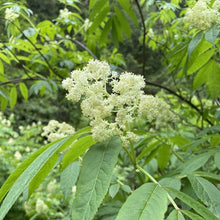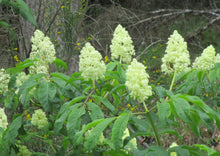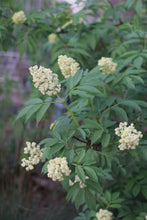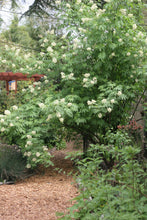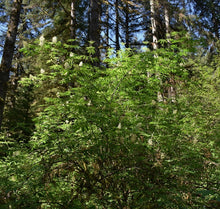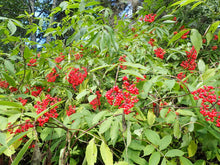
Sambucus racemosa var. arborescens
Red elderberry is a large, deciduous shrub that can easily be pruned to take the form of a small tree. In mid-spring, the branch tips are abounding with tiny fragrant white flowers that provide nectar for butterflies and bees. As spring turns to summer, flowers mature into red berries that are attractive to the gardener's eye and as food for a plethora of backyard birds. Hollow stems provide habitat for mason bees.
- Plant type/canopy layer: deciduous, large shrub
- Size at maturity: 8-18' tall, 10' wide
- Light requirements: full sun, part sun/part shade, full shade
- Moisture requirements: moist to wet soil
- Bloom time: March - August (April - May in the Portland Metro area)
- Growth rate/ease: fast growing, easy to grow
- Wildlife support: flowers attracts and supports bees, butterflies and other insect pollinators; berries are eaten by more than 30 species of local birds; brittle, pithy stems are superb insect habitat, particularly for nesting mason bees
- Native habitat/range: common in seasonally flooded streambanks and wet meadows, logged areas and woods near coast to mid-elevations across the Pacific Northwest. Portland Plant List - yes.
- Special features & uses: wildlife favorite; supports hummingbirds; landscape uses include woodland gardens and erosion control; berries are edible only when cooked (toxic to humans when raw) and can be made into wine, sauces or jelly, indigenous peoples traditionally steam the berries and store underground or in water for winter; medicinally the leaves, bark or roots can be applied topically to aching muscles and joints, flowers can be boiled down to treat coughs and colds; hollow stems can be used for whistles and pipes.
Gardening with Red Elderberry: This fast-growing, upright shrub tolerates a variety of light conditions, making it a versatile and attractive choice in many garden areas where soils are moist. Try it along the edges of your moist woodland, in a ditch, bioswale or raingarden, or along a shady fence line. It takes well to pruning and can therefore be shaped to fit into smaller gardens, in side-yards or along paths. Note - branches and small sections often die off as quickly as new branches spring forth. Don’t be alarmed as you see branches become leafless and brittle, this process is not only normal, but is creating exceptional habitat for wildlife.
Photo Credit 1 (flowers, leaves): © Hilary Rose Dawson, some rights reserved (CC-BY)
Photo Credit 2 (flowers on branch tips): © sprcrkwild, some rights reserved (CC-BY)
Photo Credits 3 & 4 (flowers, in the habitat garden): Karli Del Biondo, Beetles and Bees
Photo Credit 5 (in the wild): © Gail A Baker, some rights reserved (CC-BY)
Photo Credit 6 (berries): Nikkie West, Sparrowhawk Native Plants
Photo Credit 7 (more berries): © Matt Bowser, some rights reserved (CC-BY)







